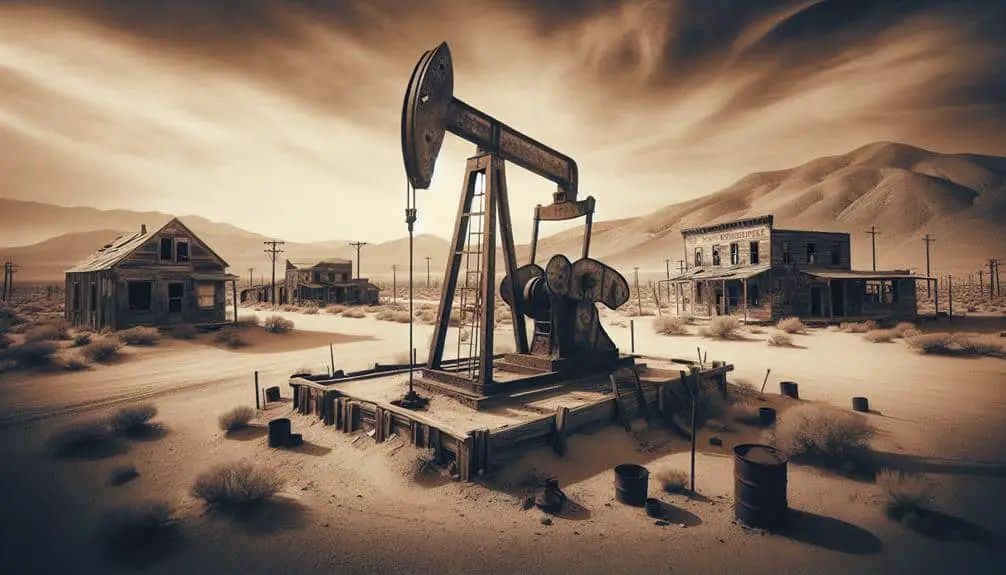In America's ruins lie the forgotten oil towns, rich with stories of boom turned to bust, reflecting the volatile history of industrial reigns. Dusty streets hint at past prosperity, now entwined with decay, telling tales of resilience in the face of decline. The abandoned saloons, stores, and homes stand as echoes of bustling days gone by, awaiting discovery. Preservation efforts seek to honor these remnants, emphasizing the importance of historical significance. As you unearth the lost oil town history, you peel back layers of a narrative woven with tales of growth, struggle, and the enduring spirit of communities.
Key Points
- Exploration of abandoned oil towns reveals rich historical narratives.
- Uncovering remnants of past prosperity sheds light on community life.
- Preservation efforts essential to safeguard unique architectural heritage.
- Tourism potential offers avenue for economic revitalization.
- Strategic planning and community involvement crucial for future sustainability.
Origins of Forgotten Oil Towns
When exploring the origins of overlooked oil towns, it becomes evident that their establishment was intricately linked to the discovery of oil reserves in the late 19th century. These early settlements sprung up rapidly as prospectors and entrepreneurs rushed to capitalize on the newfound resource. Initially, these towns were brimming with life and activity, as workers flocked to them in search of employment opportunities in the burgeoning oil industry.
However, as the years passed, many of these oil towns faced a stark reality – industrial decline. The once-thriving communities began to wither as oil reserves depleted, leading to mass layoffs and economic hardship. Businesses that had once thrived now stood abandoned, mere remnants of a bygone era. The decline of these towns serves as a significant reminder of the cyclical nature of industries tied to finite resources.
Despite their eventual demise, these forgotten oil towns played an important role in shaping the economic landscape of their time, leaving behind a legacy of resilience and adaptability in the face of industrial decline.
Boom and Bust of Oil Towns
Exploring the history of oil towns reveals a pattern of rapid growth followed by a sudden downturn, known as the boom and bust cycle. These towns experienced a rise fueled by the discovery of oil, attracting workers, investors, and businesses seeking opportunities in the burgeoning industry. The economic impact during the boom phase was significant, with a surge in population leading to the development of infrastructure, housing, and services to support the growing community.
However, the boom was often short-lived, and the sudden fall of oil prices or depletion of oil reserves could trigger the bust phase. This downturn resulted in mass layoffs, businesses closing down, and a rapid decline in population as people moved away in search of new opportunities. The rise and fall of oil towns exemplify the volatility of the industry and the challenges faced by communities dependent on a single economic resource.
Understanding this boom and bust cycle is vital for developing sustainable economic strategies and mitigating the impact of sudden economic downturns on local residents.
Daily Life in Abandoned Oil Towns
In the deserted streets of abandoned oil towns, remnants of a once-thriving community paint a stark picture of the past prosperity now lost. As you explore these relics, the echoes of daily life in these forgotten communities resonate through the dilapidated buildings and empty streets. The remnants of old saloons, stores, and houses stand as silent witnesses to the bustling activity that once filled these now desolate spaces.
Walking through these ghost towns, you can almost feel the presence of the people who once called this place home. The faded advertisements on weathered walls hint at a time when these streets were alive with commerce and conversation. Rusty playground equipment and decaying school buildings serve as poignant reminders of the families that once lived and worked in these now abandoned settlements.
Amidst the peeling paint and crumbling facades, the daily routines of these communities come to life in your mind's eye. It's a sobering experience to witness the quiet decay of what was once a vibrant hub of activity, where dreams were pursued and lives were lived.
Preservation Efforts for Ghost Towns
Efforts to maintain ghost towns involve meticulous documentation, strategic restoration, and thoughtful curation of historical artifacts. When it comes to saving these remnants of the past, attention to detail and a passion for history are key.
Here are some important aspects of preservation efforts for ghost towns:
- Historical Significance: Understanding the historical context of a ghost town is fundamental to its preservation. By delving into the stories of those who lived there, we can better appreciate the town's place in history.
- Architectural Preservation: Maintaining the unique architecture of ghost towns is essential. From old saloons to general stores, each building tells a story of the town's past.
- Community Engagement: Involving the local community in preservation efforts fosters a sense of pride and ownership. It ensures that the town's history isn't forgotten.
- Sustainable Practices: Implementing sustainable preservation practices helps guarantee that future generations can continue to learn from and enjoy these historical sites.
Future Prospects for Oil Ghost Towns
To understand the potential future of oil ghost towns, a thorough analysis of their historical significance and economic feasibility is essential. Economic revitalization could be achieved through strategic planning that leverages the unique heritage and resources of these towns. By repurposing existing infrastructure and promoting sustainable industries, such as renewable energy or heritage tourism, these towns could experience a resurgence in economic activity.
Tourism potential plays an important role in the future prospects of oil ghost towns. Preserving the historical architecture and stories of these towns can attract visitors interested in exploring the remnants of the oil boom era. Developing guided tours, interactive exhibits, and cultural events can enhance the tourist experience and generate revenue for the local economy.
Frequently Asked Questions
What Were the Main Sources of Entertainment for Residents in Abandoned Oil Towns?
In abandoned oil towns, residents found entertainment through movie nights and community gatherings. These activities provided a sense of connection and escape from the desolation surrounding them, fostering moments of joy and camaraderie.
How Did the Local Economy of These Ghost Towns Impact Surrounding Communities?
You'd think the abandoned oil towns would just fade away. Instead, their local businesses closing created ripples, affecting surrounding communities. The intricate web of community relationships unraveled, leaving a ghostly reminder of economic impact.
Were There Any Notable Historical Events or Figures Associated With These Forgotten Oil Towns?
In the forgotten oil towns, famous figures like oil barons and wildcatters once walked the dusty streets. Forgotten events, like oil booms and busts, shaped the landscape. Rediscovering these lost histories reveals intriguing secrets of the past.
What Challenges Do Preservation Efforts Face in Maintaining the Integrity of These Ghost Towns?
Preservation challenges in maintaining ghost towns' integrity stem from balancing historical significance with modern development needs. Community engagement can aid in finding solutions, but financial constraints, natural decay, and lack of awareness pose obstacles.
Are There Any Environmental Concerns Related to the Abandoned Oil Towns and Their Impact on the Surrounding Landscape?
When looking at the abandoned oil towns, you may observe various environmental concerns. The impact on the surrounding landscape is significant, with issues like soil contamination, water pollution, and abandoned infrastructure affecting the ecosystem's health.



